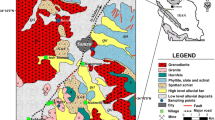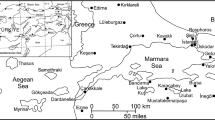Abstract
Changes in mineralogical, chemical, and mechanical properties of a rock mass during the weathering process allow calibrating the degree of weathering. Based on those properties, various weathering indices can be used as tools for this purpose. This study focuses on using chemical weathering indices that represent the chemical behaviour of a rock mass and their relationship with other properties for better evaluation of weathering grades. Metamorphic rocks that undergo weathering due to both chemical and operational means at Smanalawewa hydropower station in Sri Lanka, where tropical climate exists, were selected for this study. Among the chemical weathering indices calculated, the product index, Ruxton ratio, silica-titania index, alumina-titania index, chemical weathering index by Sueoka, and S/SAF index change consistently with progressive weathering. They correlate well with the weathering potential index, Miura index, bulk density, and point load strength. Among the six indices mentioned, the product index, Ruxton ratio, silica-titania, and alumina-titania indices have been recognised as better measures to classify metamorphic rocks in Sri Lanka for chemical means. Since there is a good correlation with physical and mechanical properties, the chemical weathering index and S/SAF index also appear to be better indices in the same context. Weathering potential, Parker, and modified weathering potential indices, which are widely used, show minor fluctuations during weathering. On the contrary, the chemical index of weathering and chemical index of alteration fluctuate with progressive weathering. These changes exhibit the influence of bulk mineral composition of the rock, where aluminium rich minerals are present. This study clearly shows that chemical weathering indices of a particular rock mass are more reliable when they correlate well with physical and mechanical properties.







Similar content being viewed by others
References
Aydin A, Duzgoren-Aydin NS (2002) Indices for scaling and predicting weathering-induced changes in rock properties. Environ Eng Geosci 8:121–135
Baynes J, Dearman WR (1978) The microfabric of a chemically weathered granite. Bull Int Assoc Eng Geol 18:91–100
Broch E, Franklin JA (1972) The point-load strength test. Int J Rock Mech Min Sci Geomech Abstr 9:669–676
Ceryan S, Tudes S, Ceryan N (2007) A new quantitative weathering classification for igneous rocks. Environ Geol 55:1319–1336
Ceryan S, Zorlu K, Gokceoglu C, Temel A (2008) The use of cation packing index for characterizing the weathering degree of granitic rocks. Eng Geol 98:60–74
Che VB, Fontijn K, Ernst GGJ et al (2012) Evaluating the degree of weathering in landslide-prone soils in the humid tropics: the case of Limbe, SW Cameroon. Geoderma 170:378–389
Chiu CF, Ng CWW (2014) Relationships between chemical weathering indices and physical and mechanical properties of decomposed granite. Eng Geol 179:76–89
Coe A, Argles T, Rothery D, Spicer R (2010) Geological field techniques, 1st edn. Wiley-Blackwell, Milton Keynes
Consolmagno GJSJ, Britt DT (1998) The density and porosity of meteorites from the Vatican collection. Meteorit Planet Sci 33:1231–1241
Cooray PG (1994) The precambrian of Sri Lanka: a historical review. Precambrian Res 66:3–18
Dearman WR, Baynes FJ, Irfan TY (1978) Engineering grading of weathered granite. Eng Geol 12:345–374
Duzgoren-Aydin NS, Aydin A (2003) Chemical heterogeneities of weathered igneous profiles: implications for chemical indices. Environ Eng Geosci 9:363–376
Duzgoren-Aydin N, Aydin A, Malpas J (2002) Re-assessment of chemical weathering indices: case study on pyroclastic rocks of Hong Kong. Eng Geol 63:99–119
Fiantis D, Nelson M, Shamshuddin J et al (2010) Determination of the geochemical weathering indices and trace elements content of new volcanic ash deposits from Mt. Talang (West Sumatra) Indonesia. Eurasian Soil Sci 43:1477–1485
Franklin JA, Chandra R (1972) The slake-durability test. Int J Rock Mech Min Sci Geomech Abstr 9:325–328
Grant WH (1964) Chemical weathering of biotite—plagioclase gneiss. Clays Clay Miner 12:455–463
Guan P, Ng CWW, Sun M, Tang W (2001) Weathering indices for rhyolitic tuff and granite in Hong Kong. Eng Geol 59:147–159
Gupta AS, Rao SK (1998) Index properties of weathered rocks: inter-relationships and applicability. Bull Eng Geol Environ 57:161–172
Gupta AS, Rao KS (2000) Weathering effects on the strength and deformational behaviour of crystalline rocks under uniaxial compression state. Eng Geol 56:257–274
Gupta AS, Rao SK (2001) Weathering indices and their applicability for crystalline rocks. Bull Eng Geol Environ 60:201–221
Harnois L (1988) The CIW index: a new chemical index of weathering. Sediment Geol 55:319–322
Haskins D (2006) Chemical and mineralogical weathering indices as applied to a granite saprolite in South Africa. In: Proc. 10th IAEG Int. Congr. The Geological Society of London, Nottingham, pp 1–14
Hill IG, Worden RH, Meighan IG (2000) Yttrium: the immobility-mobility transition during basaltic weathering. Geology 28:923–926
Hodder APW (1984) Thermodynamic interpretation of weathering indices and its application to engineering properties of rocks. Eng Geol 20:241–251
Irfan TY (1996) Mineralogy, fabric properties and classification of weathered granites in Hong Kong. Q J Eng Geol Hydrogeol 29:5–35
Irfan TY, Dearman WR (1978a) Engineering classification and index properties of a weathered granite. Bull Int Assoc Eng Geol 17:79–90
Irfan TY, Dearman WR (1978b) The engineering petrography of a weathered granite in Cornwall, England. Q J Eng Geol Hydrogeol 11:233–244
Jayawardena U de S (1993) Use of H2O+ for classification of residual soil. In: Int. Symp. Geotech. Eng. Hard Soil Soft Rocks. Amsterdam, Athanes, Greece, pp 169–171
Jayawardena U de S, Izawa E (1994a) Application of present indices of chemical weathering for precambrian metamorphic rocks in Sri Lanka. Bull Int Assoc Eng Geol 49:55–61
Jayawardena U de S, Izawa E (1994b) A new chemical index of weathering for metamorphic silicate rocks in tropical regions: a study from Sri Lanka. Eng Geol 36:303–310
Katz MB (1978) Sri Lanka in Gondwanaland and the evolution of the Indian Ocean. Geol Mag 115:237
Kim S, Park H-D (2003) The relationship between physical and chemical weathering indices of granites around Seoul, Korea. Bull Eng Geol Environ 62:207–212
Loughnan FC (1962) Some considerations in the weathering of the silicate minerals. J Sediment Res 32:284–290
Matsukura Y, Hashizume K, Oguchi C (2002) Effect of microstructure and weathering on the strength anisotropy of porous rhyolite. Eng Geol 63:39–47
Miura K (1973) Weathering in plutonic rocks (Part 1). Weathering during late Pliocene of Gotsu plutonic rocks. J Japan Soc Eng Geol 14:87–102
Momeni AA, Khanlari GR, Heidari M et al (2015) New engineering geological weathering classifications for granitoid rocks. Eng Geol 185:43–51
Moon V, Jayawardane J (2004) Geomechanical and geochemical changes during early stages of weathering of Karamu Basalt, New Zealand. Eng Geol 74:57–72
Nesbitt HW, Wilson RE (1992) Recent chemical weathering of basalts. Am J Sci 292:740–777
Nesbitt H, Young G (1982) Early Proterozoic climates and plate motions inferred from major element chemistry of lutites. Nature 299:715–717
Ng CWW, Guan P, Shang YJ (2001) Weathering mechanisms and indices of the igneous rocks of Hong Kong. Q J Eng Geol Hydrogeol 34:133–151
Nordt LC, Driese SD (2010) New weathering index improves paleorainfall estimates from Vertisols. Geology 38:407–410
Ohta T, Arai H (2007) Statistical empirical index of chemical weathering in igneous rocks: a new tool for evaluating the degree of weathering. Chem Geol 240:280–297
Parker A (1970) An index of weathering for silicate rocks. Geol Mag 107:501–504
Patino LC, Velbel MA, Price JR, Wade JA (2003) Trace element mobility during spheroidal weathering of basalts and andesites in Hawaii and Guatemala. Chem Geol 202:343–364
Price JR, Velbel MA (2003) Chemical weathering indices applied to weathering profiles developed on heterogeneous felsic metamorphic parent rocks. Chem Geol 202:397–416
Reiche P (1943) Graphic representation of chemical weathering. J Sediment Res 13:58–68
Reiche P (1945) A survey of weathering processes and products. University of New Mexico Press, Albuquerque
Rocha-Filho P, Antunes FS, Falco MFG (1985) Quantitative influence of the degree of weathering upon the mechanical properties of a young gneiss residual soil, vol 1. In: Proceedings of the First International Conference on Geomechanics in Tropical Lateritic and Saprolitic Soils, Brasilia, pp 281–294
Ruxton BP (1968) Measures of the degree of chemical weathering of rocks. J Geol 76:518–527
Souri B, Watanabe M, Sakagami K (2006) Contribution of Parker and Product indexes to evaluate weathering condition of Yellow Brown Forest soils in Japan. Geoderma 130:346–355
Sueoka T (1988) Identification and classification of granitic residual soils using chemical weathering index. In Geomechanics of Tropical Soils, Proceedings of the Second International Conference on Geomechanics in Tropical Soils, Singapore, A.A. Balkema, Rtterdam, pp. 55–61
Taylor G, Eggleton RA (2001) Regolith geology and geomorphology. Wiley, Chisester
Topal T (2002) Quantification of weathering depths in slightly weathered tuffs. Environ Geol 42:632–641
Udagedara T, Gunatilake J (2006) Causes for rapid deterioration of Samanalawewa rocks. In: Peradeniya University Research Sessions. pp 159
Ulsay R, Hudson J (2007) The complete ISRM suggested methods for rock characterization, testing and monitoring: 1974–2006. International Society on Rock Mechanics, Ankara
Vithanage PW (1970) A study of the geomorphology and the morphotectonics of Ceylon. 2nd Semin. Geochemical Prospect. Methods Tech. United Nations, New York, pp 391–405
Vogel DE (1975) Precambrian weathering in acid metavolcanic rocks from the superior province, Villebon Township, South-Central Québec. Can J Earth Sci 12:2080–2085
White K, Bryant R, Drake N (1998) Techniques for measuring rock weathering: application to a dated fan segment sequence in southern Tunisia. Earth Surf Process Landforms 23:1031–1043
Yonemura K, Osanai Y, Nakano N et al (2013) Petrology, geochemistry, and origin of metamorphosed mafic rocks of the Trans Vietnam Orogenic Belt, Southeast Asia. J Mineral Petrol Sci 108:55–86
Acknowledgments
DTU extends his gratitude to the Japanese government Monbukagakusho scholarship programme for sponsoring his doctoral study at Saitama University. Authors express their sincere gratitude to Mr T.M.S.K. Thilakarathna, DGM of Samanalawewa Complex (SHEP) of Ceylon Electricity Board (CEB), Sri Lanka for granting permission to access the SHEP facility. We further extend our thanks to the anonymous reviewers who helped to develop the quality of the manuscript and Dr. Jeremy Koonce, Department of Geoscience, University of Nevada, Las Vegas for his kind assistance on reading and correcting the manuscript language.
Author information
Authors and Affiliations
Corresponding author
Rights and permissions
About this article
Cite this article
Udagedara, D.T., Oguchi, C.T. & Gunatilake, A.A.J.K. Combination of chemical indices and physical properties in the assessment of weathering grades of sillimanite-garnet gneiss in tropical environment. Bull Eng Geol Environ 76, 145–157 (2017). https://doi.org/10.1007/s10064-016-0878-2
Received:
Accepted:
Published:
Issue Date:
DOI: https://doi.org/10.1007/s10064-016-0878-2




